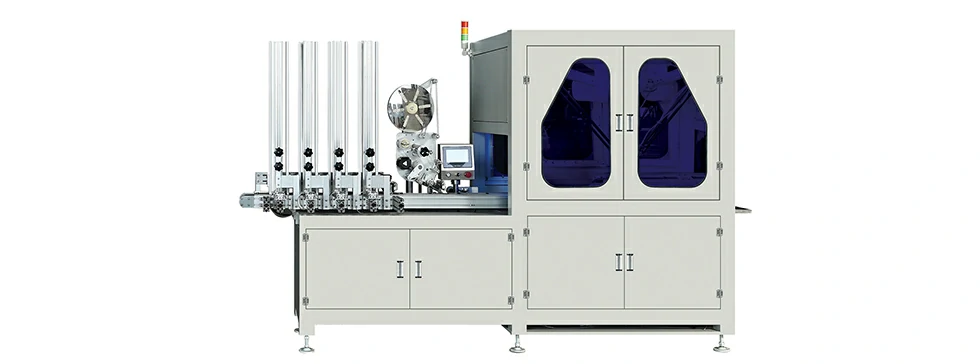Accommodating changes in lid design or specifications in a wet wipe lid capping machine involves several considerations to ensure adaptability and flexibility:
- Adjustable Settings: The machine should have adjustable settings to accommodate variations in lid sizes, shapes, and materials. Parameters such as lid diameter, height, and threading (if applicable) can often be modified to fit new lid specifications.
- Modular Components: Machines with modular components allow for easier replacements or adjustments. Components like cap chucks, capping heads, or conveyor systems might be interchangeable to accommodate different lid designs.
- Tool-Free Changeovers: Designing the machine for tool-free changeovers simplifies the process of switching between different lid designs. Quick-release mechanisms or easily adjustable parts streamline the changeover process.
- Customization Features: Advanced machines might offer customizable features that enable quick adjustments for specific lid designs. These features can include adjustable grippers, chuck inserts, or sealing mechanisms.
- Programming and Control Systems: Machines equipped with user-friendly interfaces and programmable settings allow operators to input new specifications easily. Control systems can store multiple preset configurations for various lid designs.
- Versatile Gripping Mechanisms: The machine’s gripping mechanisms, such as chuck assemblies, should be adaptable to different lid shapes and materials. Grippers that can be adjusted or customized enhance versatility.
- Integrated Sensors and Inspection: Incorporating sensors and inspection systems that detect lid dimensions, shapes, or defects can aid in automatic adjustments or rejection of lids that do not meet specified criteria.
- Mechanical Adjustments: Machines may have manual or automated mechanisms for adjusting the height, angle, or pressure of the capping heads or sealing elements to suit different lid designs.
- Compatibility Verification: Prior to production, conducting trial runs or compatibility checks with new lid designs ensures that the machine can cap lids accurately and securely without compromising quality.
- Manufacturer Support and Training: Manufacturers may offer support, training, or guidance on adapting the machine to new lid designs. wet wipe lid capping machine This includes providing documentation, training sessions, or on-site assistance.
By incorporating these features and mechanisms, a wet wipe lid capping machine can accommodate changes in lid design or specifications, allowing for adaptability to new requirements without significant downtime or complications.
What safety features are incorporated into the wet wipe lid capping machine’s operation?
Safety features integrated into wet wipe lid capping machines ensure a secure and hazard-free operating environment for machine operators and maintenance personnel.
Some common safety features include:
- Guarding and Enclosures: Physical guards and enclosures cover moving parts, capping heads, or areas with potential pinch points, preventing accidental contact by operators and minimizing the risk of injury.
- Emergency Stop Buttons: Easily accessible emergency stop buttons or switches allow immediate halting of machine operations in case of emergencies or when a hazard is identified.
- Interlocking Systems: Interlocks prevent access to certain machine components or operation unless specific conditions (e.g., machine stoppage) are met, reducing the risk of accidental operation.
- Safety Sensors: Proximity sensors or light curtains detect the presence of hands or objects in restricted areas, automatically stopping or preventing machine operation to avoid accidents.
- Warning Signs and Labels: Clear signage, warnings, and labels on the machine indicate potential hazards, operating instructions, and safety precautions to ensure operators are aware of safety protocols.
- Machine Stability: Ensuring the machine’s stability and secure anchoring to the floor prevents tipping or movement during operation, reducing the risk of accidents.
- Safety Training and Procedures: Providing comprehensive safety training to operators and maintenance personnel ensures they understand potential risks and proper safety procedures when operating or maintaining the machine.
- Safety Interconnectivity: Integration with other machinery or parts of the production line may include safety interconnectivity features. For instance, the lid capping machine might stop automatically if there’s an issue with upstream or downstream equipment.
- Lockout/Tagout (LOTO) Procedures: Implementing lockout/tagout procedures during maintenance prevents unexpected startup or energization of the machine, ensuring the safety of maintenance personnel.
- Compliance with Standards: Designing and manufacturing the machine in compliance with relevant safety standards and regulations ensures that safety features meet industry guidelines.
- Regular Maintenance Checks: Scheduled maintenance and inspections help identify and rectify potential safety hazards before they become significant risks.
By incorporating these safety features and practices, wet wipe lid capping machines prioritize the safety of personnel, minimizing the likelihood of accidents or injuries during machine operation and maintenance.
